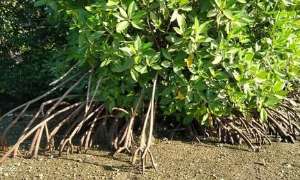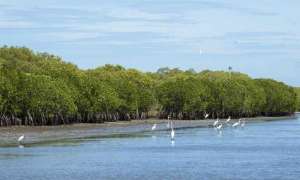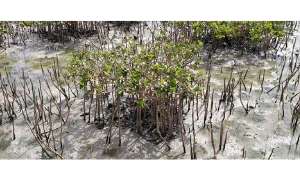
Aug 04 2020.
views 2445They are muddy, smelly and buggy but they do much more than what one may see with their naked eye. Isolated between 12,000-19,000 hectares of the island’s land area are small pockets of forest patches, popularly known as mangroves. Besides seagrasses, mangroves are the only species that have overcome hazards and successfully colonised the sea, thereby offering a great service to people. This service is greatly felt in their ability to act as natural barriers against natural calamities such as tsunamis, while mangroves are also known to absorb carbon much more than other terrestrial ecosystems. But with emerging threats from land conversions to de-gazetting nature reserves to be replaced with aquaculture projects Sri Lanka’s mangroves are under serious threat. As a result, the Wildlife and Nature Protection Society (WNPS) declared a Mangrove Week from July 27 to August 2. Hence the Daily Mirror Life takes a look at the importance of mangroves, what is being done to destroy mangroves and what the future entails.

SPECIAL ADAPTATIONS
According to Dr Sevvandi Jayakody, senior lecturer in Environmental Science at Wayamba University and member of National mangrove expert committee in her presentation at the WNPS monthly lecture said that mangroves are confined to tropical and subtropical areas while the highest number of species could be found around the Indian Ocean. “There are around 55 to 72 species across the world while Sri Lanka is home to 21 of these species. This means one-third of the global mangrove diversity is found in Sri Lanka. They create mono stands (avicennia marina) but need special adaptations to survive. Mixed stands are created when the ecosystem is just
right for many mangroves to grow along with associated species. When you go into a mangrove ecosystem you can see both these types and that’s a unique feature you see in mangrove ecosystems. Some of these adaptations include water intake and excretion of excess salt. Some leaves absorb salt, store and discard later. The soil is always anaerobic in a mangrove ecosystem and since there’s less oxygen the roots have special problems. How do they find oxygen to breathe? In mangrove plants, roots have special adaptations for soft, saline, low oxygen soils. Roots defy gravity and grow upwards to get more oxygen for the plants. They also produce a grand display of flowering and attract pollinators far and wide. Conservationists have studied complex
pollinator behaviours as well. However, certain species of mangroves including Lumnitzera littorea, Ceriops decandra and Scyphipora hydrophyllacea are not found everywhere in the country. Therefore we cannot sacrifice one mangrove stand saying it could be found everywhere.”

THREATENED BY MANKIND
Mangrove ecosystems have faced various threats in the form of land conversions and filling of mangrove ecosystems. “Large chunks of mangroves have been converted to salterns, especially in arid areas. Once abandoned they give rise to hostile landscapes where no animal or plant can survive. Since the1980s Sri Lanka has been systematically removing mangrove ecosystems especially in the Northwestern part of the country to make way for aquaculture projects. Some are active and some abandoned. Pollution is another problem along with river diversions. Mangroves provide excellent hideouts for illegal activities from producing moonshine to extracting lead from discarded batteries. The waste from these activities end up in nearby lagoons giving rise to algal blooms that produce toxins harmful for aquatic organisms and any animal that comes to drink water from these water bodies” she added.
VIDATTALTIVU NATURE RESERVE
Spanning over 29,000 hectares of land, the Vidattaltivu Nature Reserve in Mannar District was gazetted in 2016 published in Gazette Extraordinary No. 1956/13 of 01. It also acknowledged as Sri Lanka’s third-largest Marine Protected Area is under threat. It is also the only mangrove habitat that faces the sea. With the government aiming to put up an aquaculture park in the area, steps were taken to de-gazette around 1000 hectares from this sensitive ecosystem as a nature reserve. However, conservationists claim that Sri Lanka has already lost unique mangrove habitats in Puttalam, Mundel and Chilaw due to failed aquaculture projects.
As such it has been proven that pond based aquaculture is not suitable for Sri Lanka. “If you put up a shrimp farm in this area, the whole ecosystem goes out of balance,” said Graham Marshall, Marine Sub-Committee Chair at WNPS. “If this area is de-gazetted as a nature reserve there will
be a massive impact on the environment. The question is at what cost are they doing these projects? Once mangroves are taken off and aquaculture projects are done, the land is of no use afterwards.”
This is why an Environment Impact Assessment (EIA) has become a sine qua non in mass-scale development projects. Potential locations for most projects are sensitive ecosystems which are unique habitats for various species both endemic and endangered and these include both Flora and Fauna. “Scientists are willing to help the government and the environmental community is also ready for a dialogue. While we need investments we need to see that these projects have followed due process.”

SAMPALTHIVU MANGROVE ECOSYSTEM
Spanning across 242 hectares of land, the Sampalthivu mangrove system in Trincomalee District is home to many endemic species. But since it has not been gazetted as a nature reserve, around 20 hectares of land had been filled for commercial purposes. The Daily Mirror Life learned that two deeds are given away for the private investors were drafted in 1960 and conservationists raise concerns as to how the lagoon area was included. While the lagoon and other coastal areas come under the purview of the Coastal Conservation
Department, it had also been revealed that 14 private investors are claiming this land area. However, it has been observed that this project is carried out in violation of the Coastal
Conservation Amendment Act No. 49 of 2011 since the definition of a coastal zone was changed to include 100 metres of riparian land from the water bodies. So far, around 14 plots of land have been demarcated and fenced, nine others have been filled and two more plots have been illegally encroached.
However, investigations are underway as to how certain investors received deeds while conservationists and the public too are seeking justice via a public petition available on social
media. Several organisations also visited the site to plant mangrove saplings in view of International Day for the Conservation of the Mangrove System on July 26. He further said that mangroves absorb four times more carbon dioxide per hectare, which is more than what a tropical rainforest does. “In addition to that mangrove systems are home to several endangered species including the dugong. It is also home to several species of birds as well. On the other hand, people live off mangroves as they engage in coir wood, artisanal fishing and other occupations. Only a very few countries can boast of mangroves and Sri Lanka is one of them.”

ON A QUEST TO PROTECT MANGROVES
Award-winning conservationist Anoka Abeyrathne has worked with communities around Bolgoda Lake, for example, to replant mangroves and educate them on the
importance of preserving these sensitive ecosystems. “It’s not difficult per se to replant Mangroves if you understand how the ecosystem works,” said Anoka in an interview with the Daily Mirror Life. “There are two types of replantation: analogous where you provide the opportunity for regeneration and replantation. What happens with most organisations is that they get a grant and rush to plant a bunch for the photos etc. instead of understanding the ecosystem there. So if you do a scientific
analysis and understand the history of the plants that grew prior to the destruction it’s easier to renew that ecosystem and its biodiversity because you understand the needs of the plant varieties. For example, some organisations plant varieties that you find down south elsewhere so the level of salinity in the water doesn’t work great with some varieties. So quite a few factors need to be considered. The efforts included putting protective coverings, removal of objects/waste hindering root growth and to enable the communities to understand the care needed towards saplings when transplanted from nurseries.”

No environmentalist or conservationist says no to development but they constantly fight to convince lawmakers to integrate the environment in development initiatives. But in most instances, they have been failures. Speaking on development initiatives Abeyrathne said that the Katunayake highway was meant to be built through non-Mangrove lands but a former President changed the plan to get
votes that would be lost if the highway ran through voter-based lands. “So we need people who truly care about Mangroves as an ecosystem when considering development. There are ways to reconsider plans and understand the manner in which ecosystems work so that plans can be made to accommodate both. There are many great models of utilising the natural systems in ways that are not harmful to it while benefitting communities – for example, shrimp farming has been an issue
at Bolgoda to the extent, it was blocking the waterway and leading to the growth of invasive species, so stringent monitoring and support by the environmental police has helped. Land and protected areas need to be conserved at all costs.”
Protecting mangroves also benefits communities. According to Abeyrathne these include everything from ensuring that the water is filtered through the roots to providing safe spaces for fish varieties to holding river banks together to providing a natural defence against calamities like
Tsunamis the benefits are immense. Others include the ability to engage in ecotourism, sustainable forestry and carbon sinking. As a further step in protecting mangroves, she suggests the declaring of mangrove zones.
DR. SEVVANDI JAYAKODY, senior lecturer in Environmental Science at Wayamba University and
member of National mangrove expert committee “There around 55 to 72 species across the world while Sri Lanka is home to 21 of these species. This means one-third of the global mangrove diversity is found in Sri Lanka. They create mono stands (avicennia marina) but need special adaptations to survive. Mixed stands are created when the ecosystem is just right for many mangroves to grow along with associated species. When you go into a mangrove ecosystem you can see both these types and that’s a unique feature you see in mangrove ecosystems. Some of these adaptations include water intake and excretion of excess salt. Some leaves absorb salt, store and discard later. The soil is always anaerobic in a mangrove ecosystem and since there’s less oxygen the roots have special problems. How do they find oxygen to breathe? In mangrove plants, roots have special adaptations for soft, saline, low oxygen soils. Roots defy gravity and grow upwards to get more oxygen for the plants. They also produce a grand display of flowering and attract pollinators far and wide. Conservationists have studied complex pollinator behaviours as well. However, certain species of mangroves including Lumnitzera littorea, Ceriops decandra and Scyphipora hydrophyllacea are not found everywhere in the country. Therefore we cannot sacrifice
one mangrove stand saying it could be found everywhere.”
0 Comments